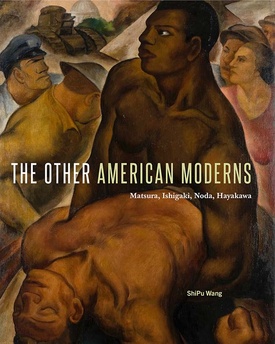I have always been intrigued by the titles authors select to represent their books, and most especially if they are as deftly apt as that ShiPu Wang has devised for the volume under review. Whereas the designation American moderns has customarily been used to depict such canonical white artists as Stuart Davis (1892-1964), Alfred Stieglitz (1864-1946), Georgia O’Keeffe (1887-1986), and John Marin (1870-1953), Wang devotes his critical attention to four American moderns of Japanese ancestry: Frank Matsura (1873-1913), Eitaro Ishigaki (1893-1958), Hideo Noda (1908-1939), and Miki Hayakawa (1899-1953). He resourcefully and strategically uses this quartet of “forgotten” minority artists—perceived by mainstream American society to be “others”—as case studies for two principal reasons. On the one hand, Wang believes that our American cultural heritage is more complex than what can be learned from merely viewing the work of a few privileged artists. On the other hand, he feels that his featured Nikkei artists helped reconceptualize American modernism through playing an active role in the formation of a multicultural and cosmopolitan culture in the United States.
Wang launches his four case studies with a pivotal image in an artist’s works so as to “uncover its historical context and underlying commentary on what ‘America,’ and living in America as a minority, meant to a diasporic artist.” For example, Wang’s chosen image for Matsura, a Japanese photographic artist in Okanogan, Wash., is Matsura and Susan Timento Pose at Studio, (ca. 1912) since Matsura frequently integrated himself into his portraits of his Native American and Caucasian clientele. As for New York-based artists Ishigaki and Noda, their respective images—The Bonus March (1932) and Scottsboro Boys (1933)—are used by Wang to show how they depicted African American heroes to intervene in and comment upon incendiary social justice issues of the Great Depression. Finally, Wang employs Hayakawa’s Portrait of a Negro (ca. 1926) to underscore the multiracial character of the life she and other Asian artists in 1920s San Francisco experienced. Together these artists created what Wang labels “imagery of the Other by the Other,” whereby “other” represents not a term of marginality, but rather a position within and a perspective on society.
Readers of The Other American Moderns should keep in mind what one of its shrewd reviewers, Samantha Snively, has sagely observed: that the era of American Modernism was one of exclusion (The Chinese Exclusion Act of 1882, Plessy v. Ferguson in 1896, the Immigration Act of 1924, among many other racist measures aimed to ascertain who counted as “American”). Small wonder then that artists like Matsura, Ishigaki, Noda, and Hayakawa were left out of the Modernist canon. Given that a new exclusionary era now threatens our country, we need to be vigilant to ensure that we resist every attempt to roll back the pluralistic advances we have made in our society and culture in the last half century under the pernicious banner of making America great once again.
The Other American Moderns: Matsura, Ishigaki, Noda, Hayakawa
By ShiPu Wang
(University Park, Penn: Pennsylvania State University Press, 2017, 196 pp., $69.95, hard cover)
*This article was originally published in the Nichi Bei Weekly on July 19, 2018.
© 2018 Arthur A. Hansen and Nichi Bei Weekly








